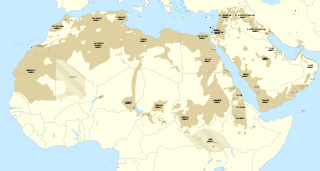Related Research Articles

The Semitic languages are a branch of the Afroasiatic language family. They include Arabic, Amharic, Hebrew, and numerous other ancient and modern languages. They are spoken by more than 330 million people across much of West Asia, North Africa, the Horn of Africa, Malta, and in large immigrant and expatriate communities in North America, Europe, and Australasia. The terminology was first used in the 1780s by members of the Göttingen school of history, who derived the name from Shem, one of the three sons of Noah in the Book of Genesis.

The Phoenician alphabet is an alphabet known in modern times from the Canaanite and Aramaic inscriptions found across the Mediterranean region. The name comes from the Phoenician civilization.

The Ugaritic writing system is a Cuneiform Abjad with syllabic elements used from around either 1400 BCE or 1300 BCE for Ugaritic, an extinct Northwest Semitic language, and discovered in Ugarit, Syria, in 1928. It has 30 letters. Other languages were occasionally written in the Ugaritic script in the area around Ugarit, although not elsewhere.
Phoenician is an extinct Canaanite Semitic language originally spoken in the region surrounding the cities of Tyre and Sidon. Extensive Tyro-Sidonian trade and commercial dominance led to Phoenician becoming a lingua franca of the maritime Mediterranean during the Iron Age. The Phoenician alphabet spread to Greece during this period, where it became the source of all modern European scripts.
The Canaanite languages, sometimes referred to as Canaanite dialects, are one of three subgroups of the Northwest Semitic languages, the others being Aramaic and Amorite. These closely related languages originate in the Levant and Mesopotamia, and were spoken by the ancient Semitic-speaking peoples of an area encompassing what is today Israel, Jordan, the Sinai Peninsula, Lebanon, Syria, Palestine, as well as some areas of southwestern Turkey (Anatolia), western and southern Iraq (Mesopotamia) and the northwestern corner of Saudi Arabia.

Mot was the Canaanite god of death and the Underworld. He was also known to the people of Ugarit and in Phoenicia, where Canaanite religion was widespread. The main source of information about Mot in Canaanite mythology comes from the texts discovered at Ugarit, but he is also mentioned in the surviving fragments of Philo of Byblos's Greek translation of the writings of the Phoenician Sanchuniathon.
Over recorded history, there have been many names of the Levant, a large area in the Middle East, or its constituent parts. These names have applied to a part or the whole of the Levant. On occasion, two or more of these names have been used at the same time by different cultures or sects. As a natural result, some of the names of the Levant are highly politically charged. Perhaps the least politicized name is Levant itself, which simply means "where the sun rises" or "where the land rises out of the sea", a meaning attributed to the region's easterly location on the shore of the Mediterranean Sea.
Shin is the twenty-first letter of the Semitic abjads, including Phoenician šīn 𐤔, Hebrew šīn ש, Aramaic šīn 𐡔, Syriac šīn ܫ, and Arabic sīn س. Its sound value is a voiceless sibilant, or.
Tsade is the eighteenth letter of the Semitic abjads, including Phoenician ṣādē 𐤑, Hebrew ṣādī צ, Aramaic ṣāḏē 𐡑, Syriac ṣāḏē ܨ, Ge'ez ṣädäy ጸ, and Arabic ṣād ص. Its oldest phonetic value is debated, although there is a variety of pronunciations in different modern Semitic languages and their dialects. It represents the coalescence of three Proto-Semitic "emphatic consonants" in Canaanite. Arabic, which kept the phonemes separate, introduced variants of ṣād and ṭāʾ to express the three. In Aramaic, these emphatic consonants coalesced instead with ʿayin and ṭēt, respectively, thus Hebrew ereṣ ארץ (earth) is araʿ ארע in Aramaic.
Proto-Semitic is the hypothetical reconstructed proto-language ancestral to the Semitic languages. There is no consensus regarding the location of the Proto-Semitic Urheimat: scholars hypothesize that it may have originated in the Levant, the Sahara, the Horn of Africa, the Arabian Peninsula, or northern Africa.
Zayin is the seventh letter of the Semitic abjads, including Phoenician zayn 𐤆, Hebrew zayīn ז, Aramaic zain 𐡆, Syriac zayn ܙ, and Arabic zāy ز. It represents the sound.
Teth, also written as Ṭēth or Tet, is the ninth letter of the Semitic abjads, including Phoenician ṭēt 𐤈, Hebrew ṭēt ט, Aramaic ṭēṯ 𐡈, Syriac ṭēṯ ܛ, and Arabic ṭāʾ ط. It is the 16th letter of the modern Arabic alphabet. The Persian ṭa is pronounced as a hard "t" sound and is the 19th letter in the modern Persian alphabet. The Phoenician letter also gave rise to the Greek theta (Θ), originally an aspirated voiceless dental stop but now used for the voiceless dental fricative. The Arabic letter (ط) is sometimes transliterated as tah in English, for example in Arabic script in Unicode.
Ayin is the sixteenth letter of the Semitic scripts, including Phoenician ʿayin 𐤏, Hebrew ʿayin ע, Aramaic ʿē 𐡏, Syriac ʿē ܥ, and Arabic ʿayn ع.
Noon is the fourteenth letter of the Semitic abjads, including Phoenician nūn 𐤍, Hebrew nūn נ, Aramaic nūn 𐡍, Syriac nūn ܢ, and Arabic nūn ن. Its numerical value is 50. It is the third letter in Thaana (ނ), pronounced as "noonu". In all languages, it represents the alveolar nasal /n/.
The history of the alphabet goes back to the consonantal writing system used for Semitic languages in the Levant in the 2nd millennium BCE. Most or nearly all alphabetic scripts used throughout the world today ultimately go back to this Semitic proto-alphabet. Its first origins can be traced back to a Proto-Sinaitic script developed in Ancient Egypt to represent the language of Semitic-speaking workers and slaves in Egypt. Unskilled in the complex hieroglyphic system used to write the Egyptian language, which required a large number of pictograms, they selected a small number of those commonly seen in their Egyptian surroundings to describe the sounds, as opposed to the semantic values, of their own Canaanite language. This script was partly influenced by the older Egyptian hieratic, a cursive script related to Egyptian hieroglyphs. The Semitic alphabet became the ancestor of multiple writing systems across the Middle East, Europe, northern Africa, and Pakistan, mainly through Ancient South Arabian, Phoenician, Paleo-Hebrew and later Aramaic, four closely related members of the Semitic family of scripts that were in use during the early first millennium BCE.

The Philistine language is the extinct language of the Philistines. Very little is known about the language, of which a handful of words survived as cultural loanwords in Biblical Hebrew, describing specifically Philistine institutions, like the seranim, the "lords" of the Philistine five cities, or the ’argáz receptacle, which occurs in 1 Samuel 6 and nowhere else, or the title padî.
Northwest Semitic is a division of the Semitic languages comprising the indigenous languages of the Levant. It emerged from Proto-Semitic in the Early Bronze Age. It is first attested in proper names identified as Amorite in the Middle Bronze Age. The oldest coherent texts are in Ugaritic, dating to the Late Bronze Age, which by the time of the Bronze Age collapse are joined by Old Aramaic, and by the Iron Age by Sutean and the Canaanite languages.

Ancient Semitic-speaking peoples or Proto-Semitic people were speakers of Semitic languages who lived throughout the ancient Near East and North Africa, including the Levant, Mesopotamia, the Arabian Peninsula and Carthage from the 3rd millennium BC until the end of antiquity, with some, such as Arabs, Arameans, Assyrians, Jews, Mandaeans, and Samaritans having a continuum into the present day.
References
- ↑ "aloe". Online Etymology Dictionary.
- ↑ Kim Schulte (2009). "Loanwords in Romanian". In Martin Haspelmath; Uri Tadmor (eds.). Loanwords in the World's Languages: A Comparative Handbook. Walter de Gruyter. pp. 230–59., 234. Schulte draws a further match with proto-Germanic *hamithjan. Whichever borrowed from whomever, the proto-Germans got it prior to Grimm's Law *k->h, and the Latins got it from the later Celts.
- ↑ From Late-Antique Greek καμίσιον kamision, the word migrated to pre-classical Arabic (Q. 12:18-28, 93; also poetry) قميص qamiṣ 'shirt' and to Ethiopic qamas and to Syriac (not earlier Aramaic) qûmisié. Arthur Jeffery. The Foreign Vocabulary of the Qur'an. Baroda: Oriental Institute. p. 243. Jeffery's reference to Syriac is from Fraenkel (1886), 45; to "Ethiopic" from Josippon. Leslau [Wolf Leslau (1990). Arabic Loanwords in Ethiopian Semitic., 74] assumes also from Fraenkel that Arabic-speakers delivered these Greek and Syrian shirts to the Ethiopians. Fraenkel would imply, further, that these traders provided the Syrian spelling for these shirts. καμίσιον itself might derive from the Celtic or the Vulgar Latin.
- ↑ "fig (n. 1)". Online Etymology Dictionary. Retrieved 13 August 2016.
- ↑ "sapphire". Online Etymology Dictionary.
- AHD: American Heritage Dictionary
- FD: The Free Dictionary – ONLINE
- MW: Merriam-Webster's Collegiate Dictionary – ONLINE
- OED: Oxford English Dictionary – ONLINE
- RHD: Random House Dictionary – ONLINE
- NI: Webster's New International Dictionary
- SC: Strong's Concordance
- WNW: Webster's New World Dictionary : 3rd edition